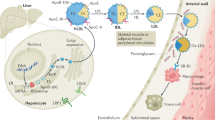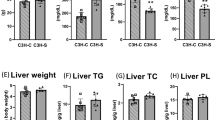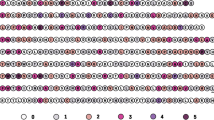Abstract
Epidemiological, pathological and genetic studies show a strong positive correlation between elevated plasma concentrations of low-density lipoprotein (LDL) cholesterol and the risk of premature coronary heart disease1–3. Apolipoprotein (apo) B-100 is the sole protein component of LDL and is the ligand responsible for the receptor-mediated uptake and clearance of LDL from the circulation2–6. Apo B-100 is made by the liver and is essential for the assembly of triglyceride-rich very low-density lipoproteins (VLDL) in the cisternae of the endoplasmic reticulum and for their secretion into the plasma. VLDL transports triglyceride to peripheral muscle and adipose tissue, where the triglyceride is hydrolysed by lipoprotein lipase. The resultant particle, relatively enriched in cholesteryl ester, constitutes LDL. LDL delivers cholesterol to peripheral tissues where it is used for membrane and steroid hormone biosynthesis and to the liver, the only organ which can catabolize and excrete cholesterol. Plasma LDL levels are therefore determined by the balance between their rate of production from VLDL and clearance by the hepatic LDL (apo B/E) receptor pathway. Here we report the complete 4,563-amino-acid sequence of apo B-100 precursor (relative molecular mass (Mr) 514,000 (514K)) determined from complementary DNA clones. Numerous lipid-binding structures are distributed throughout the extraordinary length of apo B-100 and must underlie its special functions as a nucleus for lipoprotein assembly and maintenance of plasma lipoprotein integrity. A domain enriched in basic amino-acid residues has been identified as important for the cellular uptake of cholesterol by the LDL receptor pathway.
This is a preview of subscription content, access via your institution
Access options
Subscribe to this journal
Receive 51 print issues and online access
$199.00 per year
only $3.90 per issue
Buy this article
- Purchase on Springer Link
- Instant access to full article PDF
Prices may be subject to local taxes which are calculated during checkout
Similar content being viewed by others
References
LaRosa, J. C., Glueck, C. J. & Segal, M. D. Circulation 73, 1–133 (1986).
Havel, R. J., Goldstein, J. L. & Brown, M. S. in Metabolic Control and Disease (eds Bondy, P. K. & Rosenberg, L. E.) 393–494 (Saunders, Philadelphia, 1980).
Goldstein, J. L. & Brown, M. S. in The Metabolic Basis of Inherited Disease (eds Stanbury, J. B. et al.) 672–712 (McGraw-Hill, New York, 1983).
Mahley, R. W., Innerarity, T. L., Rall, S. C. & Weisgraber, K. H. J. Lipid Res. 25, 1277–1294 (1984).
Kane, J. P. A. Rev. Physiol. 45, 637–650 (1983).
Breslow, J. L. A. Rev. Biochem. 54, 699–727 (1985).
Knott, T. J. et al. Nucleic Acids Res. 13, no. 18 (1986).
Cardin, A. D. et al. J. biol. Chem. 239, 8522–8528 (1984).
Lee, P. & Breckenridge, W. C. Can. J. Biochem. 54, 42–49 (1976).
Chou, P. Y. & Fasman, G. D. A. Rev. Biochem. 47, 251–276 (1978).
Cardin, A. D., Witt, K. R., Barnhart, C. L. & Jackson, R. L. Biochemistry 21, 4503–4511 (1982).
Segrest, J. P., Jackson, R. L., Morrisett, J. D. & Gotto, A. M. FEBS Lett. 38, 347–353 (1974).
Kaiser, E. T. & Kezdy, F. J. Science 223, 249–255 (1984).
Osterman, D., Mora, R., Kezdy, F. J., Kaiser, E. T. & Meredith, S. C. J. Am. chem. Soc. 106, 6845–6847 (1984).
Kyte, J. & Doolittle, R. F. J. molec. Biol. 157, 105–132 (1982).
Van't Hooft, F. & Havel, R. J. J. biol. Chem. 256, 3963–3968 (1981).
Südhof, T. C. et al. Science 228, 893–895 (1985).
Doolittle, R. F. Trends biochem. Sci. 10, 233–237 (1985).
Freedman, R. B. Trends biochem. Sci. 9, 438–441 (1984).
Edman, J. C., Ellis, L., Blacher, R. W., Roth, R. A. & Rutter, W. J. Nature 317, 267–270 (1985).
Yamamoto, T., Bishop, R. W., Brown, M. S., Goldstein, J. L. & Russell, D. W. Science 232, 1230–1237 (1986).
Christensen, N. J., Rubin, C. E., Cheung, M. C. & Albers, J. J. J. Lipid Res. 24, 1229–1242 (1983).
Vauhkonen, M., Vitala, J., Parkkinen, J. & Rauvala, H. Eur. J. Biochem. 152, 43–50 (1985).
Siuta-Mangano, P., Janero, D. R. & Lane, M. D. J. biol. Chem. 257, 11463–11467 (1982).
Eisenberg, S. & Levy, R. I. Adv. Lipid Res. 13, 1–89 (1975).
Teng, B. et al. J. biol. Chem. 260, 5067–5072 (1985).
Innerarity, T. L., Friedlander, E. J., Rall, S. C., Weisgraber, K. H. & Mahley, R. W. J. biol. Chem. 258, 12341–12347 (1983).
Weisgraber, K. H. et al. J. biol. Chem. 258, 12348–12354 (1983).
Innerarity, T. L. et al. J. biol. Chem. 259, 7261–7267 (1984).
Knott, T. J. et al. Science 230, 37–43 (1985).
Elovson, J., Jacobs, J. C., Schumaker, V. N. & Puppione, D. L. Biochemistry 24, 1569–1578 (1985).
Deckelbaum, R. J., Shipley, G. G. & Small, D. M. J. biol. Chem. 252, 744–754 (1977).
Berg, K. & Bearn, A. B. Clin. Genet. 1, 104–120 (1970).
Rapasz, M. & Hasler-Rapasz, J. Fedn Proc. 72, 2347–2351 (1985).
Young, S. G., Bertics, S. J., Curtiss, L. K., Casal, D. C. & Witztum, J. L. Proc. natn. Acad. Sci. U.S.A. 83, 1101–1105 (1986).
Berg, K. et al. Proc. natn. Acad. Sci. U.S.A. (in the press).
Hardman, D. A., Gustafson, A., Schilling, J. W., Donaldson, V. H. & Kane, J. P. Biochem. biophys. Res. Commun. 137, 821–825 (1986).
LeBoeuf, R. C. et al. FEBS Lett. 170, 105–108 (1984).
Belt, K. I., Carroll, M. C. & Porter, R. R. Cell 36, 907–914 (1984).
Kane, J. P., Hardman, D. A. & Paulus, H. E. Proc. natn. Acad. Sci. U.S.A. 77, 2465–2469 (1980).
Eisenberg, D., Schwarz, E., Komaromy, M. & Wall, R. J. molec. Biol. 179, 125–142 (1984).
Marcel, Y. L., Hogue, M., Theolis, R. & Milne, R. W. J. biol. Chem. 257, 13165–13168 (1982).
Young, S. G., Witztum, J. L., Casal, D. C., Curtiss, L. K. & Bernstein, S. Arteriosclerosis 6, 178–188 (1986).
Ruther, U. & Müller-Hill, B. EMBO J. 2, 1791–1794 (1983).
Johnston, S., Lee, J. H. & Ray, D. S. Gene 34, 137–145 (1985).
Burnette, W. N. Analyt. Biochem. 112, 195–203 (1981).
Author information
Authors and Affiliations
Rights and permissions
About this article
Cite this article
Knott, T., Pease, R., Powell, L. et al. Complete protein sequence and identification of structural domains of human apolipoprotein B. Nature 323, 734–738 (1986). https://doi.org/10.1038/323734a0
Received:
Accepted:
Issue Date:
DOI: https://doi.org/10.1038/323734a0
This article is cited by
-
Predictive Modeling and Structure Analysis of Genetic Variants in Familial Hypercholesterolemia: Implications for Diagnosis and Protein Interaction Studies
Current Atherosclerosis Reports (2023)
-
Identification of Receptor Ligands in Apo B100 Reveals Potential Functional Domains
The Protein Journal (2018)
-
Development and partial characterisation of an antiserum against apolipoprotein B of the short-finned eel, Anguilla australis
Journal of Comparative Physiology B (2014)
-
Conformation and stability properties of B17: II. Analytical investigations using differential scanning calorimetry
European Biophysics Journal (2013)
-
Molecular structure of low density lipoprotein: current status and future challenges
European Biophysics Journal (2009)
Comments
By submitting a comment you agree to abide by our Terms and Community Guidelines. If you find something abusive or that does not comply with our terms or guidelines please flag it as inappropriate.



